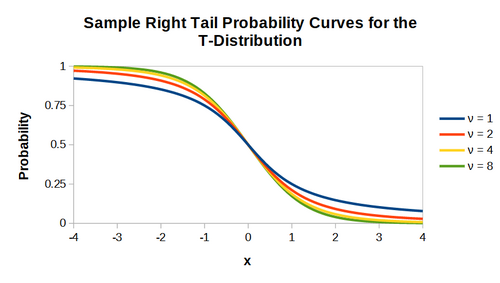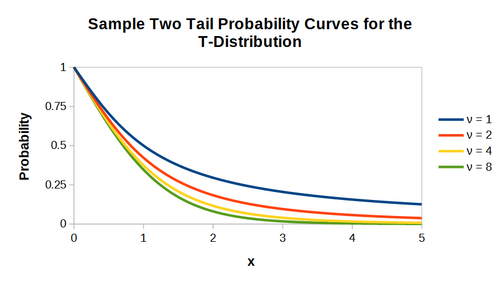Documentation/Calc Functions/TDIST
TDF LibreOffice Document Liberation Project Community Blogs Weblate Nextcloud Redmine Ask LibreOffice Donate
Function name:
TDIST
Category:
Statistical Analysis
Summary:
Calculates right tail or two-tailed probability values for the t-distribution. The t-distribution is often known as the Student's t-distribution.
T-distributions are a family of continuous probability distributions and each has a curve with the same general bell shape that is symmetric about 0. Each t-distribution is characterized by a parameter known as the number of degrees of freedom, often denoted by the lowercase Greek letter nu ([math]\displaystyle{ \nu }[/math]). The t-distribution approaches the normal distribution as the number of degrees of freedom increases. T-distributions are often used to model small sample sizes.
Syntax:
TDIST(Number; Degrees freedom; Mode)
Returns:
Returns a real number in the range [0, 1], which is the required probability value for the given arguments. This represents the total area under the appropriate tail or tails of the probability density function of the specified t-distribution.
Arguments:
Number is a non-negative real number, or a reference to a cell containing that number, which is the value at which the probability is to be evaluated.
Degrees freedom is a positive integer, or a reference to a cell containing that number, which is the number of degrees of freedom of the t-distribution. This is typically assumed to be the number of samples minus 1.
Mode is an integer equal to 1 or 2, or a reference to a cell containing that number, which indicates which probability to calculate. Value 1 corresponds to a right tail probability; value 2 corresponds to a two-tailed probability.
- If any of Number, Degrees freedom, or Mode is non-numeric, then TDIST reports a #VALUE! error.
- If Number is less than 0, then TDIST reports an invalid argument error (Err:502).
- If either Degrees freedom or Mode is a non-integer value, then TDIST truncates it to an integer value.
- If Degrees freedom is less than 1, then TDIST reports an invalid argument error (Err:502).
- If, after any truncation, Mode is not equal to 1 or 2, then TDIST reports an invalid argument error (Err:502).
Additional details:
- Calc's TDIST function meets the requirements of the LEGACY.TDIST function in ODF 1.2.
- Calc provides four related functions that return values from the t-distribution and these are:
- T.DIST. Calculates t-distribution values from either the probability density function or the cumulative distribution function of the specified t-distribution. These are sometimes referred to as "left tailed" values.
- T.DIST.2T. Calculates the total area under the two tails of the probability density function of the specified t-distribution. This represents the total probability that the value of a random variable lies below [math]\displaystyle{ -\text{ABS}(Number) }[/math] or above [math]\displaystyle{ +\text{ABS}(Number) }[/math].
- T.DIST.RT. Calculates the total area under the right tail of the probability density function of the specified t-distribution. This represents the total probability that the value of a random variable lies above Number.
- TDIST. A dual purpose function that can calculate either of the two types of value calculated by T.DIST.2T or T.DIST.RT.
- The formula for calculating a right tail or two-tailed probability for the t-distribution is:
- [math]\displaystyle{ \text{TDIST}(x;\:\nu;\:m)~=~m \times \int_{x}^{\infty}\frac{ \Gamma\!\left(\frac{\nu +1}{2}\right)}{\sqrt{\pi\:\nu}~~\Gamma\!\left(\frac{\nu}{2}\right)}\left (1+\frac{t^2}{\nu}\right)^{ -\frac{(\nu+1)}{2}} dt }[/math]
- where
- [math]\displaystyle{ \Gamma }[/math] is the gamma function.
- [math]\displaystyle{ \nu }[/math] is the (positive) number of degrees of freedom of the t-distribution.
- [math]\displaystyle{ m }[/math] is the value of the Mode argument.
- Note that the random variable x in the above formula often appears as t in other sources.
- The following figure shows right tail probability plots for four sample t-distributions.

- The following figure shows two-tailed probability plots for four sample t-distributions.

- For valid arguments, the following relationships exist with other Calc functions:
TDIST(x; y; 1) = T.DIST.RT(x; y)TDIST(x; y; 2) = T.DIST.2T(x; y)
- For more information on the t-distribution, visit Wikipedia's Student's t-distribution page.
Examples:
| Formula | Description | Returns |
|---|---|---|
| =TDIST(A1; A2; A3) where cells A1:A3 contain the values 0.5, 2, and 1 respectively. | Here the function calculates the right tail probability for the given values. Note that the formula =TDIST(0.5; 2.9; 1.9) returns the same value because the Degrees freedom and Mode arguments are truncated to integer values. |
0.333333333333333 |
| =TDIST(0; 25; 1) | Here the function calculates the value of the right tail probability when the Number argument is set to 0. Note that with Number equal to 0, a call to TDIST with Mode set to 1 returns the same result for any valid value of the Degrees freedom argument. | 0.5 |
| =TDIST(0.5; 2; 2) | Here the function calculates the two-tailed probability for the given values. | 0.666666666666667 |
| =TDIST(0; 25; 2) | Here the function calculates the peak value of the two-tailed probability for the t-distribution with 25 degrees of freedom. Note that if the Number argument is set to 0, a call to TDIST with Mode set to 1 returns the same result for any valid value of the Degrees freedom argument. | 1 |
Related LibreOffice functions:
ODF standard:
Related (or similar) Excel functions:
TDIST